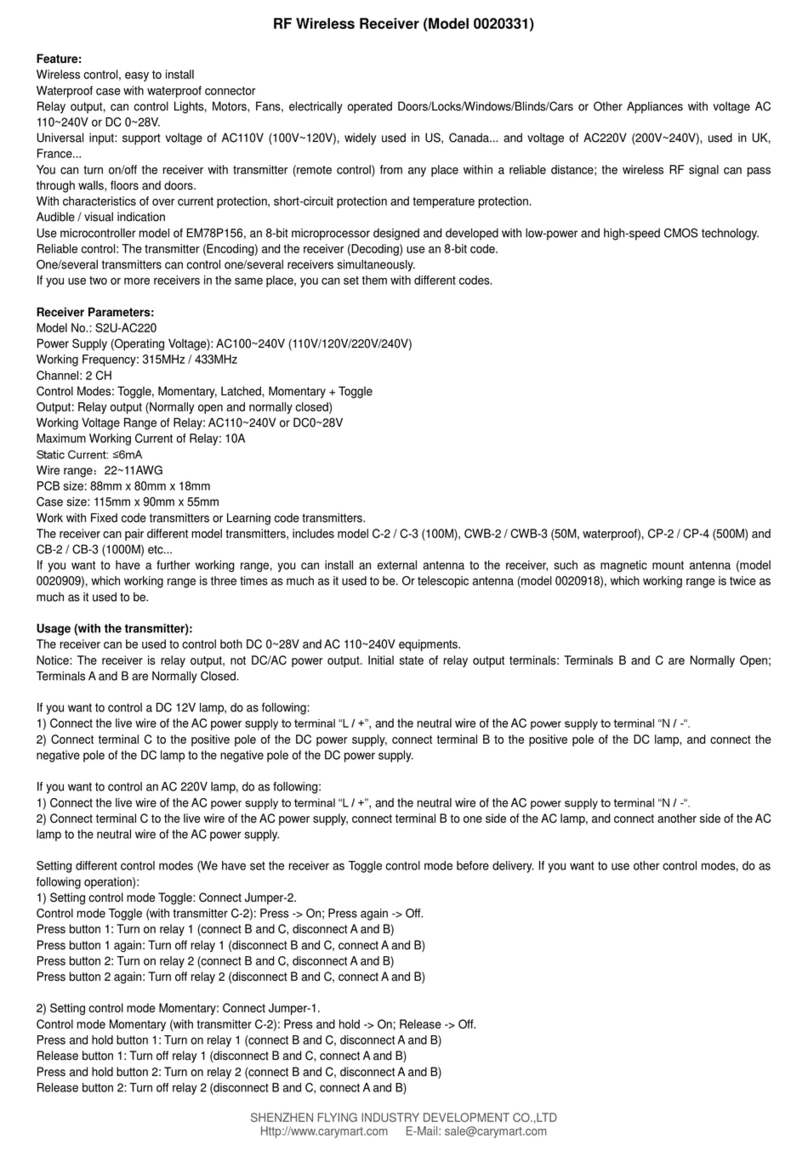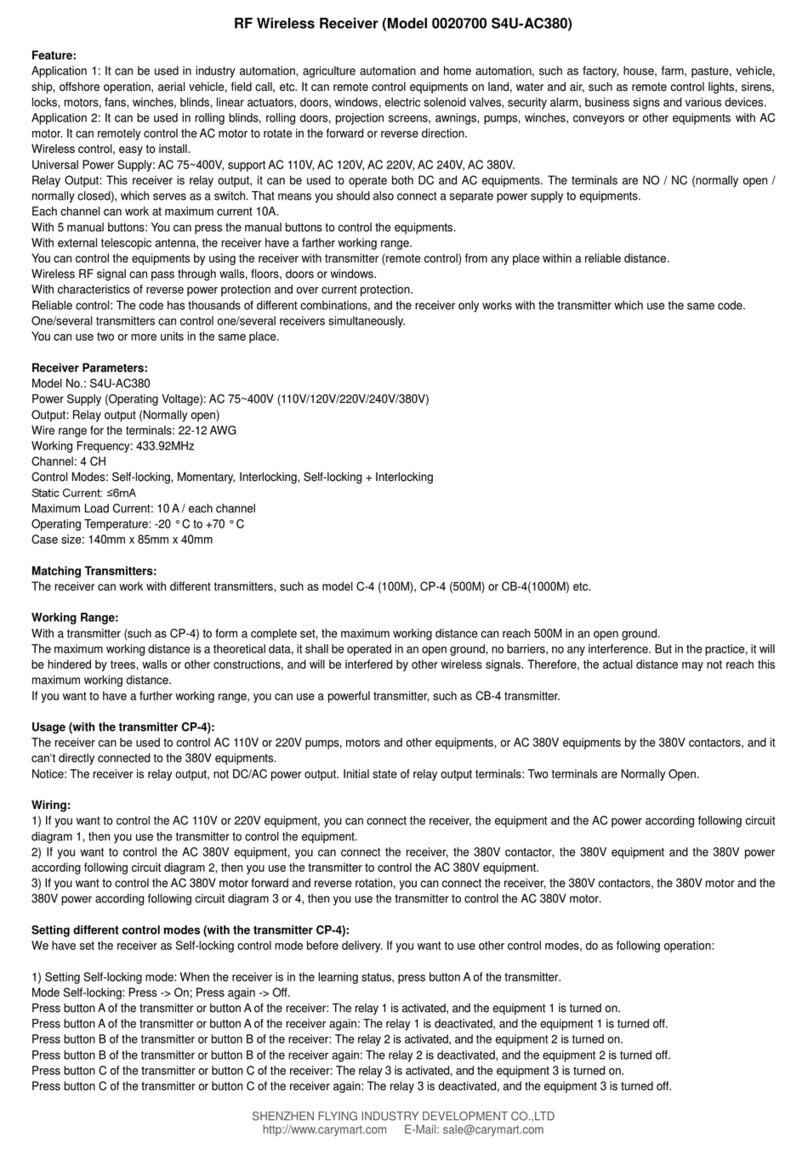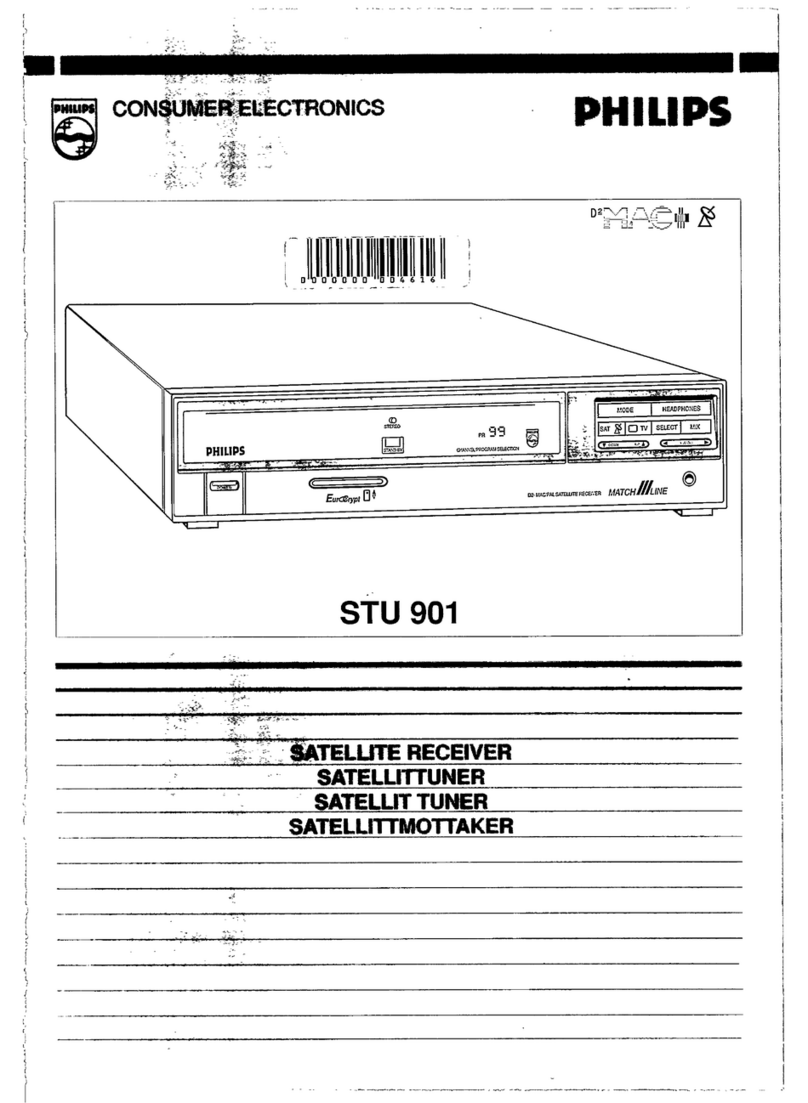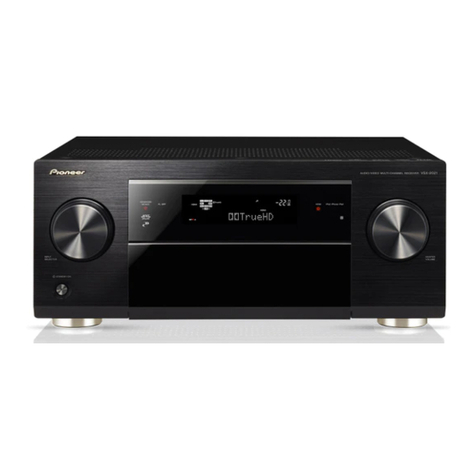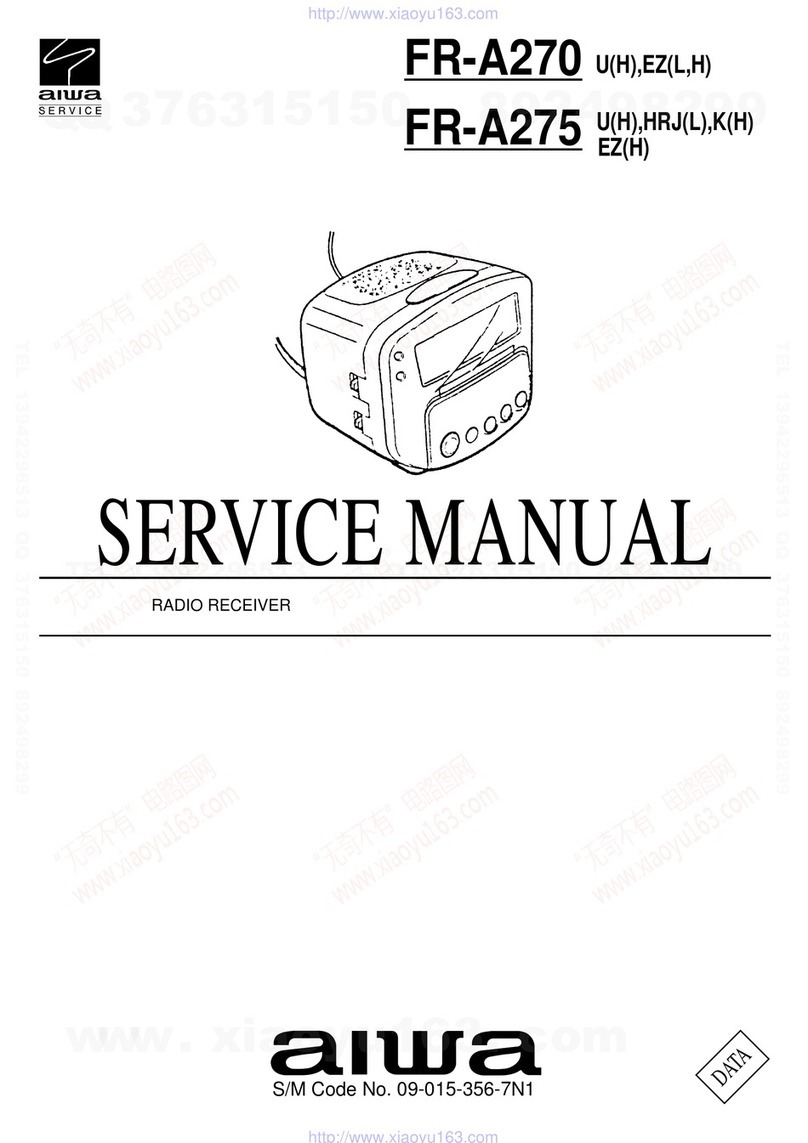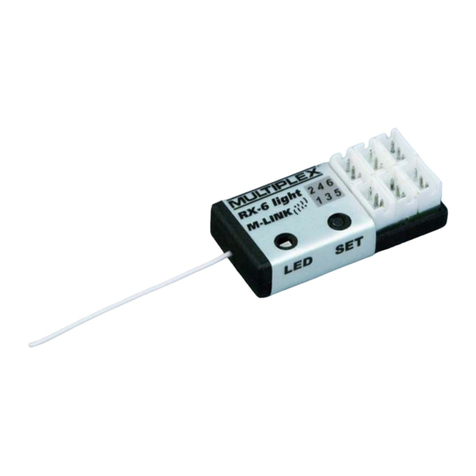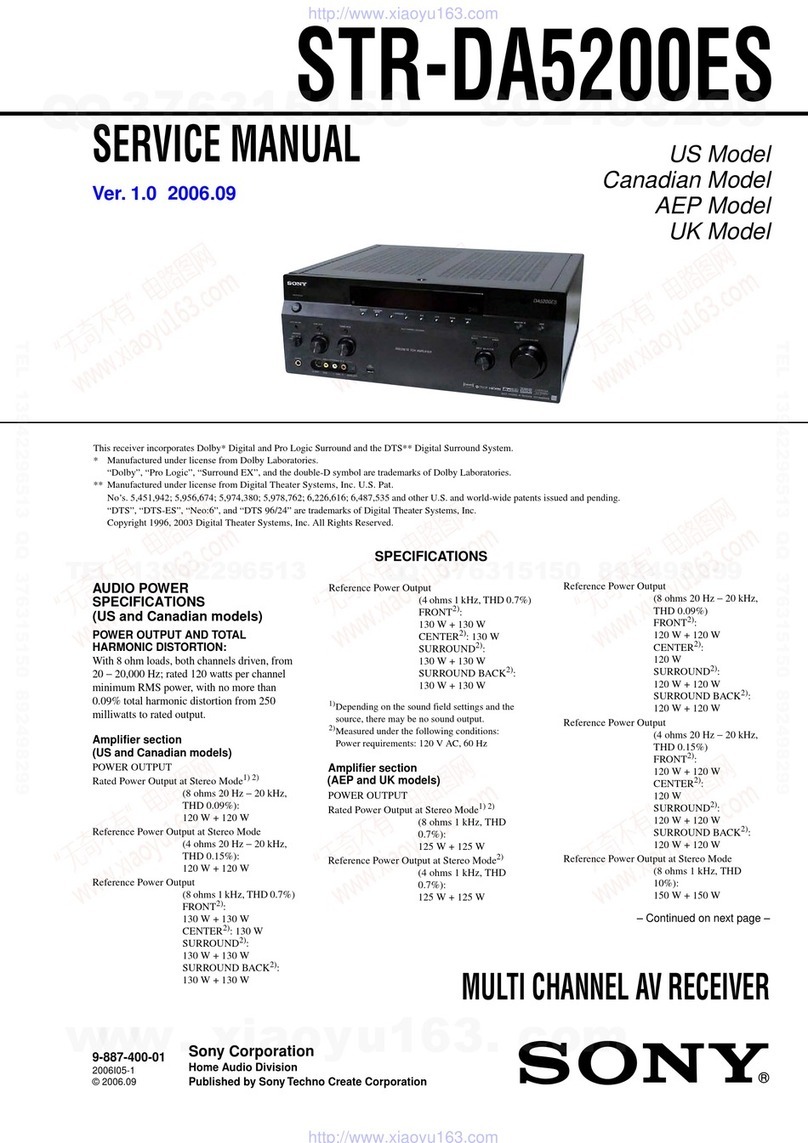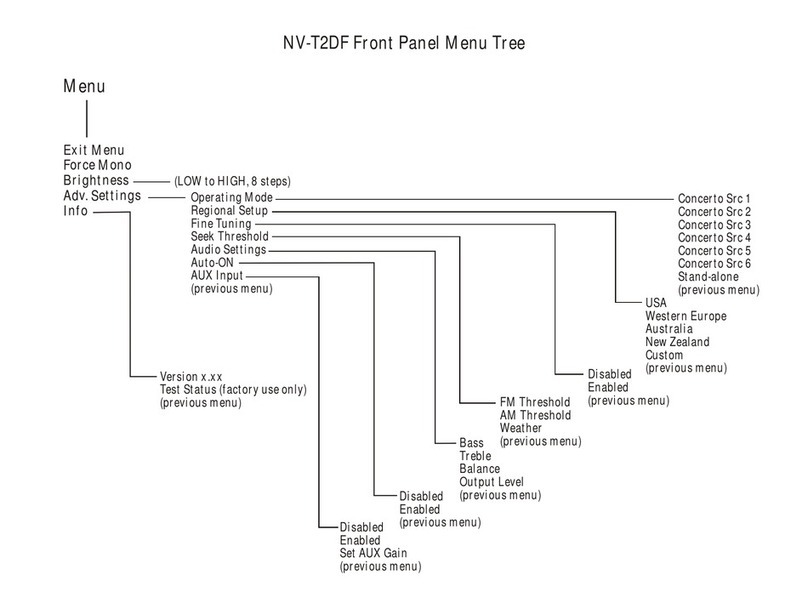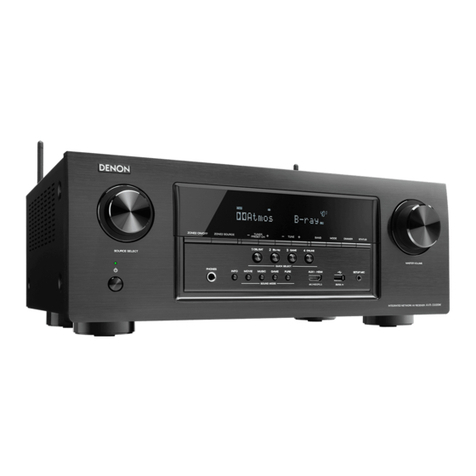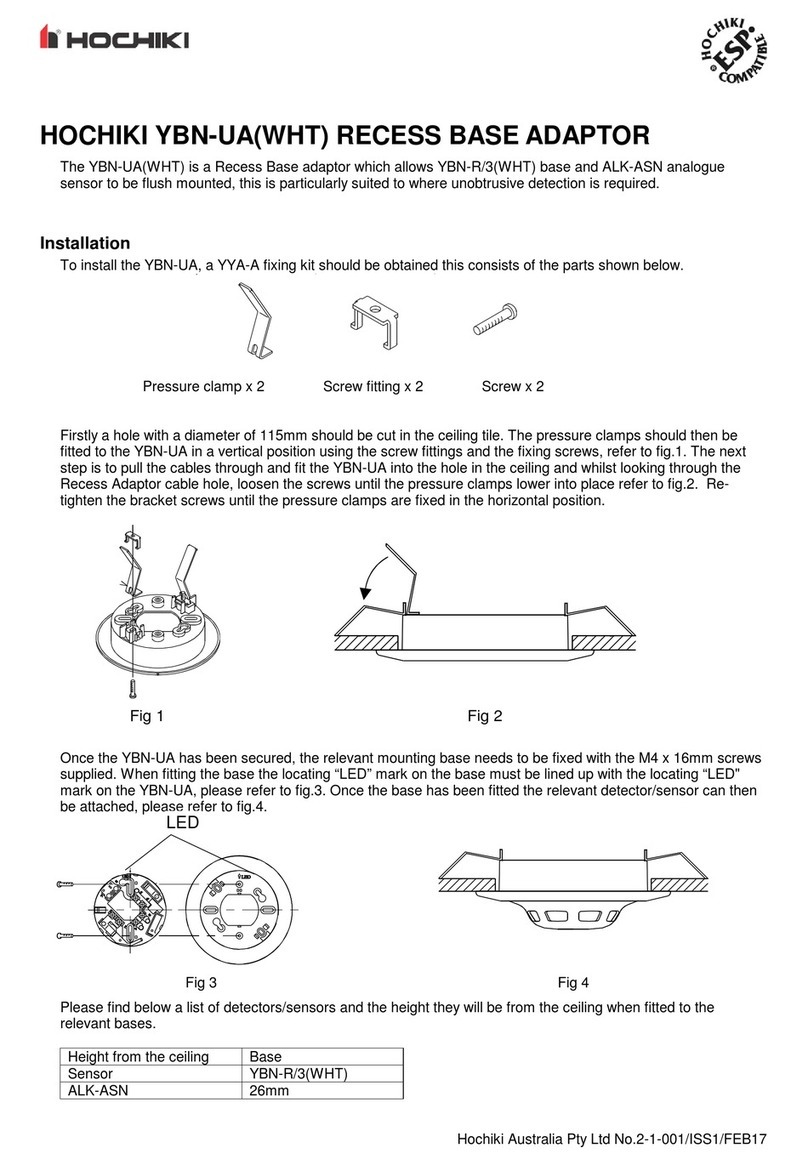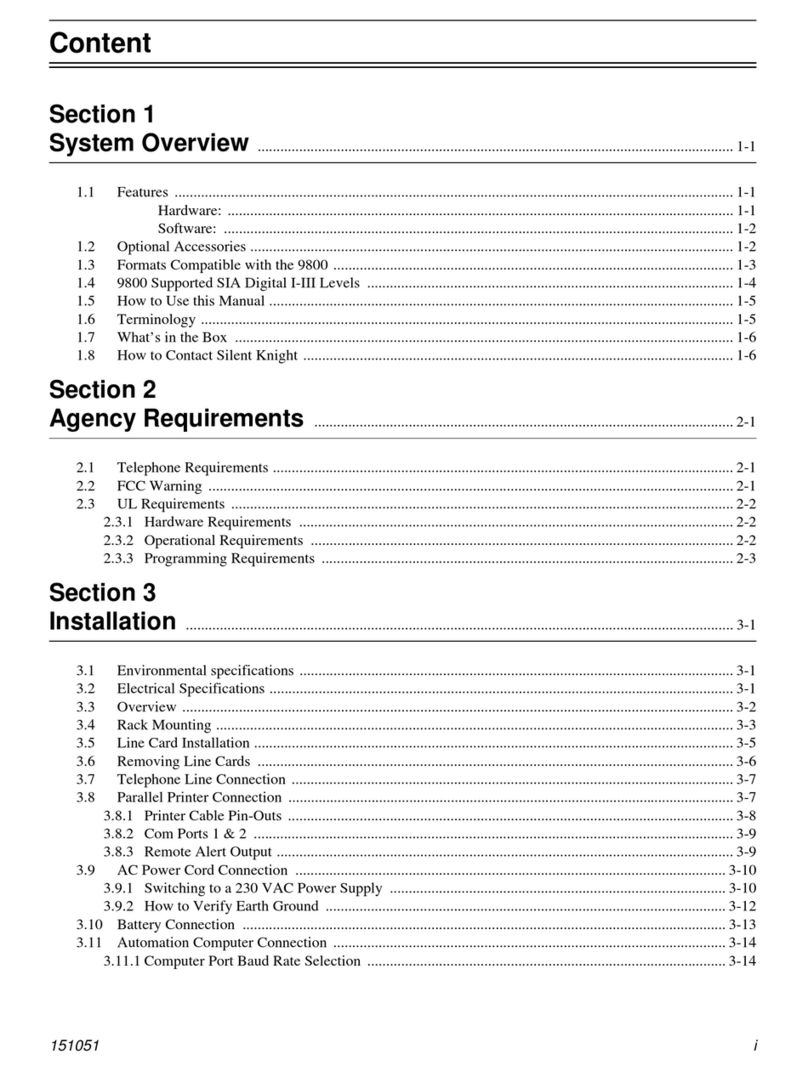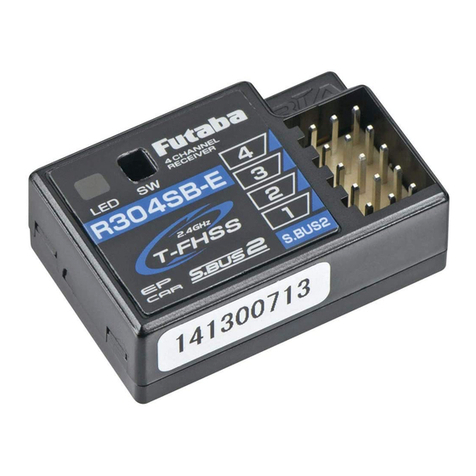SHENZHEN FLYING INDUSTRY DEVELOPMENT S1PUW-AC-ANT3 User manual

SHENZHEN FLYING INDUSTRY DEVELOPMENT CO.,LTD
Http://www.carymart.com E-Mail: sale@carymart.com
5000 Meters RF Wireless Receiver (Model 0020091 S1PUW-AC-ANT3)
Feature:
Application: It can be used in industry automation, agriculture automation and home automation, such as factory, house, farm, pasture, vehicle, ship,
offshore operation, aerial vehicle, field call, etc. It can remote control equipments on land, water and air, such as remote control lights, sirens, locks,
motors, fans, winches, blinds, linear actuators, doors, windows, electric solenoid valves, security alarm, business signs and various devices.
The installation of wireless control is easy and fast.
Super long range, with a transmitter to form a complete set, the working distance can reach 5000m in an open ground.
Waterproof: The receiver has waterproof case and waterproof connector, it can be installed outdoors.
AC Power Output: It can control AC equipment with voltage 110V / 120V / 220V / 240VAC.
High Power: Each channel can work at maximum current 30A, such as 360W/12V, 180W/6V, 270W/9V, 720W/24V, 3000W/110V, 6000W/220V.
Relay Output: This receiver is relay output, it can be used to operate both DC andAC equipments. Theterminal is NO / NC (normally open / normally
closed), which serves as a switch. That means you should also connect a separate power supply to equipments..
With wired control terminals: You can connect sensors, limit switches, manual switches or external devices to control the receiver.
With the external antenna :it can have a further working range.
You can control the equipments by using the receiver with transmitter (remote control) from any place within a reliable distance.
Wireless RF signal can pass through walls, floors, doors or windows.
With characteristics of reverse power protection and over current protection.
Reliable control: The code has thousands of different combinations, and the receiver only works with the transmitter which use the same code.
One/several transmitters can control one/several receivers simultaneously.
You can use two or more units in the same place.
Feedback function:
The receiver and the transmitter have a Two-way working mode, and the user can know the working status of receiver by the transmitter in such a
long distance.
Two-way working mode: When you press the remote control to send RF signal to the receiver, if the receiver has been successfully triggered or
operated, the receiver will immediately transmit a RF feedback signal to the remote control. Then the remote control will send out a buzzing sound to
inform you that the receiver has been successfully operated.
Receiver Parameters:
Model No. S1PUW-AC-ANT3
Power Supply (Operating Voltage): AC100~240V (110V/120V/220V/240V)
Working Voltage Range of Relay: AC110~240V or DC0~28V
Working Frequency: 433.92MHz
Channel: 1 CH
Control Modes: Toggle, Momentary, Latched.
Output: Relay output (Normally open and normally closed)
Static Current: ≤6mA
Maximum Working Current: 30A / each channel
PCB size: 90mm x 59mm x 18mm
Case size: 100mm x 68mm x 50mm
External Telescopic Antenna:
Length of external telescopic antenna: 108mm / 445mm (stretch)
With SMA connector.
If you stretches the external telescopic antenna, it can have a further working range.
Matching Transmitters:
This receiver only works with 5000m transmitters, such as model CC-1 / CC-2 / CC-4 (5000M), or CCW-1 / CCW-2 / CCW-3 / CCW-4 (5000M,
waterproof).
When you set the receiver in toggle mode or momentary mode, it should work with single button transmitter, such as model CC-1 (5000m) or CCW-1
(5000m, waterproof. When you set the receiver in latched mode, it should work with two buttons transmitter, such as model CC-2 (5000m) or CCW-2
(5000m, waterproof).
Working Range:
Super long range, with a transmitter (such as CC-2) to form a complete set, the maximum working distance can reach 5000M in an open ground.
The maximum working distance is an ideal range , it shall be operated with no barriers and interference in an open ground. But in the practice, it will
be hindered by trees, walls or other constructions, and will be interfered by other wireless sign. Therefore, the actual distance may not reach this
maximum working distance.
Usage (with the transmitter CC-2):
The receiver can be used to control both DC 0~28V and AC 110~240V equipments.
Notice: The receiver is relay output, not DC/AC power output. Initial state of relay output terminals: Terminals B and C are Normally Open; Terminals
A and B are Normally Closed.
Wiring:
1) If you want to control a DC 12V lamp, do as following:
1.1 Connect the live wire of AC power supply to terminal “L / +” of INPUT, and connect the neutral wire of AC power supply to terminal “N / -”of
INPUT.

SHENZHEN FLYING INDUSTRY DEVELOPMENT CO.,LTD
Http://www.carymart.com E-Mail: sale@carymart.com
1.2 Connect terminal B to the positive pole of DC power supply, connect terminal C to the positive pole of DC lamp, and connect the negative pole of
DC lamp to the negative pole of DC power supply.
2) If you want to control an AC 220V lamp, do as following:
2.1 Connect the live wire of AC power supply to terminal “L / +” of INPUT, and connect the neutral wire of AC power supply to terminal “N / -”of
INPUT.
2.2 Connect terminal B to the live wire of AC power supply, connect terminal C to one side of AC lamp, and connect another side of AC lamp to the
neutral wire of AC power supply.
Setting different control modes:
We have set the receiver in toggle mode before delivery, if you want to use other modes, do as following operation.
1) Setting control mode Toggle: Turn on the first bit of the dip switch.
Control mode Toggle (with transmitter CC-1): Press -> On; Press again -> Off.
Press the button of the transmitter: Turn on the relay (connect B and C, disconnectA and C), the lamp is turned on.
Press the button again: Turn off the relay (disconnect B and C, connect A and C), the lamp is turned off.
2) Setting control mode Momentary: Turn on the first and the second bits of the dip switch.
Control mode Momentary (with transmitter CC-1): Press and hold -> On; Release -> Off.
Press and hold button of the transmitter: Turn on the relay (connect B and C, disconnect A and C), the lamp is turned on.
Release the button: Turn off the relay (disconnect B and C, connectA and C), the lamp is turned off.
3) Setting control mode Latched: Turn on the second bit of the dip switch.
Control mode Latched (with transmitter CC-2): Press button 1 -> On; Press button 2 -> Off.
Press the big button of the transmitter: Turn on the relay (connect B and C, disconnectA and C), the lamp is turned on.
Press the small button of the transmitter: Turn off the relay (disconnect B and C, connectA and C), the lamp is turned off.
Wired control terminals:
The receiver has wired control terminals, you can connect external devices, sensors, limit switches or manual switches to trigger the receiver.
1) By low level signal:
You can connect external devices (with low level output signal) to trigger the receiver.
When external device outputs low level signal to terminal 1 (Signal -) and terminal 2 (Signal +), turn on the relay, and the lamp is turned on.
When external device stops to output signal, turn off the relay, and the lamp is turned off.
2) By NO/NC contact:
You can connect manual switches (with NO/NC contact) to trigger the receiver.
When connect terminals 1 and 2 by manual switch, turn on the relay, and the lamp is turned on.
When disconnect terminals 1 and 2 by manual switch, turn off the relay, and the lamp is turned off.
Setting feedback function:
If you want to switch on the feedback function, you need to turn on the third bit of the dip switch.
When the receiver gets the signal of transmitter, it will immediately send a return signal to the transmitter. When the transmitter receive the feedback
signal of the receiver, the transmitter will exude a buzzing sound like “D~” which means it receive the feedback signal successfully.
How to pair the transmitter to the receiver:
1) Press the learning button of receiver for 1- 2 seconds; the signal LED of receiver is turned on. The receiver starts the LEARNING procedure.
2) Press any one button on transmitter, if signal LED flashes twice, it means learning is successful.
3) The receiver can learn several transmitters with different codes.
Delete all transmitters:
We have learned remote control to the receiver. If you don’t want the receiver to work with the remote control, you can delete all codes of remote
controls, which are stored in the receiver.
Operation: Press and hold the button of receiver until signal LED flashes three times. That means all stored codes have been deleted successfully.

SHENZHEN FLYING INDUSTRY DEVELOPMENT CO.,LTD
Http://www.carymart.com E-Mail: sale@carymart.com
Control DC Lamp
+
DC0~
28V
Power LED
_
3
1
2
ON
Signal LED
Learning Button
A
B
C
Status LED
AC Power supply
dip switch
3
2
Manual Terminals
1
2
DC Power supply
L/+
N/-
Control AC Lamp
AC Lamp
Power LED
3
1
2
ON
Signal LED
Learning Button
A
B
C
Status LED
AC Power supply
dip switch
Manual Terminals
1
2
AC Power supply
L/+
N/-
Live Wire
Neutral Wire
Neutral Wire
Live Wire
Live Wire
Neutral Wire
DC Lamp
Relay
Relay
This manual suits for next models
1
Other SHENZHEN FLYING INDUSTRY DEVELOPMENT Receiver manuals

